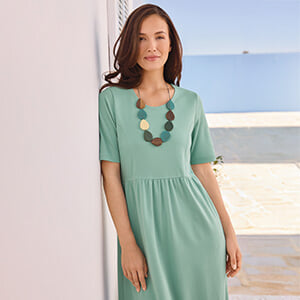
You might be forgiven for overlooking the paisley print as it is so commonplace in fashion, however, the history behind this print is anything but. Its rich cultural past starts in the ancient Persian empire and takes a detour via the Scottish town of Paisley to modern-day staple.
The paisley print symbol (also known as a boteh or buta, meaning shrub) originates from the ancient Persian Empire and is said to depict a cypress tree and flames, symbolising rebirth and new beginnings as the seeds of the cypress plant require fire to germinate, bringing new life to the scorched ground, like a phoenix rising from the ashes.
The paisley design is perhaps most famous for being printed onto shawls. The word shawl derives from the Persian 'shal' meaning a woven piece of fabric rather than an article of clothing. These shawls were woven from the soft wool of Pashmina goats (hence the term Pashmina scarf) in Kashmir since the 11th century. The East India Company then exported them in the 17th century to Europe where they became an essential part of any respectable lady's wardrobe (Did you know: the paisley shape was known as a Persian pickle in 18th century America?).
Due to the rise in popularity of the paisley shawls, Edinburgh, Norwich and Paisley began to reproduce the exotic shawls, however, it was Paisley that overtook the other cities due to developments in manufacturing processes enabling faster and higher quality production to meet the huge demand. Before long the town of the Paisley became synonymous with the Kashmir shawl and its print. Mills sprung up around Paisley and thousands of workers descended upon the town.
The curator of London's Fashion and Textile Museum, Dennis Nothdruft, discusses paisley print's place in the cultural realm of the Victorian era: "Trade between Britain and India was buoyant and Liberty’s forward-thinking founder Arthur Lasenby [capitalised on this and so] Liberty quickly expanded thanks largely to a paisley-orientated collection. William Morris and the Arts-and-Crafts movement adapted the print, with the Pre-Raphaelites depicting sumptuous paisley textiles in their paintings. It became an integral part of the Aesthetic Movement and the Art Nouveau Movement – and shorthand for sophisticated, arty bohemianism."
The paisley print held fast in fashion for over a century as the shawls draped perfectly over crinolines until the invention of the bustle, which looked less attractive with a shawl draped awkwardly over it. This fashion trend also coincided with the Franco-Prussian war which halted exports from Kashmir, as well as the fact that the paisley shawl was so common, no-one now wanted one. This led to the decline in industry in Paisley and eventual collapse of the weaving mills (You can live in the old mills, such as Anchor Mill, which has been converted into apartments).
Despite this lapse in popularity, the paisley print enjoyed a resurgence in the 1960s, when the emergence of a free-thinking generation heralded the exploration of new ideas and trends. Cheaper travel led to a wider understanding of the world and different cultures and rediscovery of the symbol, which carried with it connotations of luxury and the exotic. The Beatles, the Rolling Stones and other pop icons wore paisley prints, which helped launch the pattern back into popular culture. The pattern was re-purposed, using bold colours and sizes to appeal to this new generation.
Since then, it has remained in popular use and has a starring role in our collection for summer.

These stunning pieces utilise the striking print to full effect, from the lotus and boteh print on the chiffon blouse to the feminine colours and shapes on the jersey knot dress.

This matching blouse and skirt, in rich, fiery hues of paprika and marigold, are evocative of sunsets and the earthy tones of Indian summers.
Does the paisley print hold pride of place in your wardrobe? Do you have a favourite piece from our collection? Let us know by leaving a comment using the box below.
For more interesting updates and special offers, sign up to our email newsletters here.
You have requested to switch to our Cotswold Collections store.
Do you want to continue?


